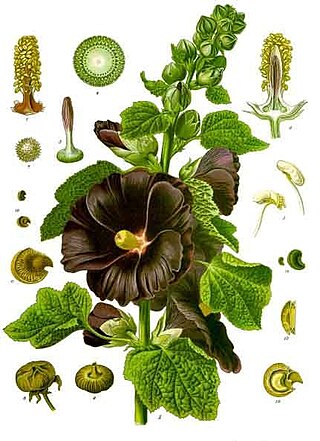
Capparales is a botanical name of an order of flowering plants. It was used in the Cronquist system for an order in subclass Dilleniidae and in the Kubitzki system, nowadays. In the 1981 version of this system it included :
The Cronquist system is a taxonomic classification system of flowering plants. It was developed by Arthur Cronquist in a series of monographs and texts, including The Evolution and Classification of Flowering Plants and An Integrated System of Classification of Flowering Plants (1981).

Malvaceae, or the mallows, is a family of flowering plants estimated to contain 244 genera with 4225 known species. Well-known members of economic importance include okra, cotton, cacao, and durian. There are also some genera containing familiar ornamentals, such as Alcea (hollyhock), Malva (mallow), and Tilia. The genera with the largest numbers of species include Hibiscus, Pavonia, Sida, Ayenia, Dombeya, and Sterculia.

Bombacaceae were long recognised as a family of flowering plants or Angiospermae. The family name was based on the type genus Bombax. As is true for many botanical names, circumscription and status of the taxon has varied with taxonomic point of view, and currently the preference is to transfer most of the erstwhile family Bombacaceae to the subfamily Bombacoideae within the family Malvaceae in the order Malvales. The rest of the family were transferred to other taxa, notably the new family Durionaceae. Irrespective of current taxonomic status, many of the species originally included in the Bombacaceae are of considerable ecological, historical, horticultural, and economic importance, such as balsa, kapok, baobab and durian.

Violales is a botanical name of an order of flowering plants and takes its name from the included family Violaceae; it was proposed by Lindley (1853). The name has been used in several systems, although some systems used the name Parietales for similar groupings. In the 1981 version of the influential Cronquist system, order Violales was placed in subclass Dilleniidae with a circumscription consisting of the families listed below. Some classifications such as that of Dahlgren placed the Violales in the superorder Violiflorae.

Tiliaceae is a family of flowering plants. It is not a part of the APG, APG II and APG III classifications, being sunk in Malvaceae mostly as the subfamilies Tilioideae, Brownlowioideae and Grewioideae, but has an extensive historical record of use.
Sterculiaceae was a family of flowering plant based on the genus Sterculia. Genera formerly included in Sterculiaceae are now placed in the family Malvaceae, in the subfamilies: Byttnerioideae, Dombeyoideae, Helicteroideae and Sterculioideae.

Myrothamnus is a genus of flowering plants, consisting of two species of small xerophytic shrubs, in the southern parts of tropical Africa and in Madagascar. Myrothamnus is recognized as the only genus in the family Myrothamnaceae.
The Kubitzki system is a system of plant taxonomy devised by Klaus Kubitzki, and is the product of an ongoing survey of vascular plants, entitled The Families and Genera of Vascular Plants, and extending to 15 volumes in 2018. The survey, in the form of an encyclopedia, is important as a comprehensive, multivolume treatment of the vascular plants, with keys to and descriptions of all families and genera, mostly by specialists in those groups. The Kubitzki system served as the basis for classification in Mabberley's Plant-Book, a dictionary of the vascular plants. Mabberley states, in his Introduction on page xi of the 2008 edition, that the Kubitzki system "has remained the standard to which other literature is compared".

Columniferae is a descriptive botanical name. The Wettstein system used this name for an order of flowering plants, with the following circumscription:

Tilioideae is a flowering plant subfamily in the family Malvaceae, though it was formerly considered a large group, placed at family rank and called Tiliaceae.

Malvoideae is a botanical name at the rank of subfamily, which includes in the minimum the genus Malva. It was first used by Burnett in 1835, but was not much used until recently, where, within the framework of the APG System, which unites the families Malvaceae, Bombacaceae, Sterculiaceae and Tiliaceae of the Cronquist system, the aggregate family Malvaceae is divided into 9 subfamilies, including Malvoideae. The Malvoideae of Kubitzki and Bayer includes 4 tribes:

Caryophyllales is a diverse and heterogeneous order of flowering plants that includes the cacti, carnations, amaranths, ice plants, beets, and many carnivorous plants. Many members are succulent, having fleshy stems or leaves. The betalain pigments are unique in plants of this order and occur in all its families with the exception of Caryophyllaceae and Molluginaceae.
Durioneae is a tribe within the subfamily Helicteroideae of the plant family Malvaceae s.l. The tribe contains at least five genera, including Durio, the genus of tree species that produce Durian fruits.
Septotheca is a genus of trees in the family Malvaceae. It contains a single species Septotheca tessmannii, native to Peru, Colombia and Brazil.

Plagianthus is a genus of flowering plants confined to New Zealand and the Chatham Islands. The familial placement of the genus was controversial for many years, but modern genetic studies show it definitely belongs in the Malvaceae subfamily Malvoideae. The name means "slanted flowers".
Krapovickasia is a genus of flowering plants in the mallow family Malvaceae, disjunctly distributed in Mexico, Brazil, Paraguay, Uruguay and Argentina. Perennial herbs, they have yellowish to peach or faded rose colored flowers.
Bastardiastrum is a genus of flowering plants in the mallow family Malvaceae and is native to Mexico. They are shrubs or subshrubs with viscid stems.

Corynabutilon is a genus of flowering plants in the family Malvaceae, native to southern Chile and Argentina. They are shrubs or small trees.














